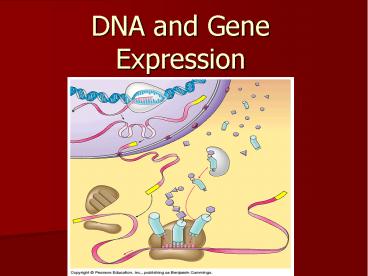DNA and Gene Expression PowerPoint PPT Presentation
Title: DNA and Gene Expression
1
DNA and Gene Expression
2
DNA
- Deoxyribonucleic Acid
- Double helix
- Carries genetic information
- Located in the nucleus
- The monomer is a nucleotide
- A phosphate
- A ribose sugar
- A nitrogenous base
3
What are the bases in DNA
- A adenine
- T thymine
- C cytosine
- G guanine
- Base pair rules
4
Where is DNA located in the Cell?
5
Where are the genes located?
- Genes are located on the chromosomes.
- Every species has a different number of
chromosomes. - There are two types of chromosomes autosomes
and sex chromosomes
6
- Genes are located on the chromosomes which are
found in the nucleus of a cell. - When a cell is undergoing cell reproduction, the
chromosomes are visible. Chromosomes appear when
the chromatin condenses and become visible. - Most of the time (90) the genetic material in
the form of chromatin. - A genome is the complete genetic information
contained in an individual. - (gene chromosome)
7
What is gene expression?
- Gene expression is the activation of a gene that
results in a protein.
8
Gene expression takes place differently in
prokaryotes and eukaryotes. What is a
prokaryotes? Eukaryotes?
- Prokaryotes
- No membrane bound organelles (nucleus)
- More primitive organisms
- Only one circular chromosome
- Bacteria are the only organisms that are
prokaryotes.
- Eukaryotes
- Membrane bound organelles ( specialize in
function nucleus, mitochondria, chloroplast) - Chromosomes are in pairs and not circular
- All organisms that are not bacteria protist,
fungi, plants and animals
9
- In Eukaryotes, following mitosis or meiosis, DNA
recoils but certain regions remain relaxed for
transcription. The areas of relaxed DNA are
called euchromatin. - Transcription is the
- Reading of the DNA and
- Changing the code to
- mRNA.
- Translation is changing
- The mRNA into a trait by
- Using tRNA to interpret the
- mRNA.
10
- DNA in eukaryotes has regions of coding and
noncoding DNA. The regions of DNA that code for
proteins or traits are called EXONS, while the
regions that do not code for proteins are called
INTRONS.
cytoplasm
cytoplasm
11
- In prokayotes, transcription and translation
occur in the cytoplasm. - In eukaryotes, transcription occurs inside the
nucleus in a two step sequence of events. - Pre-mRNA includes both introns and exons for the
gene. - mRNA is only the coding portion (exons).
- Translation occurs in the cytoplasm at the
ribosomes. - Reminder The are three (3) types of RNA
- Messenager (mRNA)
- Transfer (tRNA)
- Ribsomal (rRNA)
12
Translation
- RNA
- Single stranded
- Does not contain thymine but has uracil instead.
- tRNA carries 3 base pair code for specific amino
acid. - Amino acids compose polypeptid chains.
- One or more polypeptide chains compose a protein
- proteins provide the blueprints for our
characteristics and functions.
13
- In Prokaryotes there are three (3) regulatory
elements that control gene expression. - Structural genes genes that code for a specific
polypeptide (protein). - Promoter DNA segment that recognizes RNA
polymerase. - Operator element that serves as a binding site
for an inhibitor protein that blocks
transcription.
14
Enhancer Control
- Eukaryote genes on a DNA strand also have
noncoding control sequences that facilitate
transcription. - These are called enhancers.
- Transcription factors are additional proteins
that bind to RNA polymerase and enhancers to help
with transcription.
15
Cell Differentiation
- Cell differentiation is the development of cells
into cells with specialized functions. - Examples muscle cells, liver cell, red blood
cells - As organisms grow and develop, organs and tissues
develop to produce a characteristic form. The
process is call morphogenesis.
16
Homeotic Genes
- Homeotic genes are regulatory genes that
determine where certain anatomical structures,
such as appendages, will develop in an organism
during morphogenesis. - These seem to be the master genes of development
Mutant with legs growing out of head
Normal
17
Homeobox
- In Drosophila (fruit flies) the specific DNA
sequence within a homeotic gene that regulates
patterns of development is the homeobox. - The same or very similar homeobox sequences have
been found in many other eukaryotic organisms
18
Cancer
- Leading cause of death in the United States
- A genetic disease caused by a mutation in the
genes that control cell division
19
- Tumor abnormal proliferation of cells that
results from uncontrolled, abnormal cell division - Benign a tumor that remains within a mass
- Malignant tumor- uncontrolled dividing cells that
invade and destroy healthy tissue elsewhere in
the body - Metastasis spread of cancer cells beyond their
original site
20
Kinds of Cancer
- Carcinomas grow in skin and tissues that line
the organs of the body - Example lung and breast
- Sarcomas grow in bone and muscle tissue
- Lymphomas solid tumors that grow in tissues
that form blood cells - Example leukemia
21
- In normal cells, that frequency of cell division
is governed by several factors - Adequate nutrition
- Attachment to other cells, membranes or fibers
- Division stops if cell become crowded (usually
after 20 50) divisions - Cancer cell continue dividing and ignore the
normal messages to stop dividing.
22
What Causes Cancer?
- Mutations that alter the genes coding for growth
factors. - May occur spontaneously
- Result from exposure to an carcinogen
- ( any substance that increases the risk of
cancer.) - Usually there is more than one mutation.
- There are two types of genes that control cell
division - Proto-oncogens
- Tumor suppressing genes (p53 gene)

